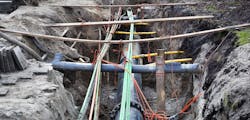Staying Safe While Excavating in Congested Environments:
With more than 20 million miles of buried infrastructure in the United States and more being added every day, it has never been more important to adhere to the Common Ground Alliance (CGA) Best Practices in excavation to help ensure the safety and connectedness of your employees and the communities you serve.
While the information and communications technology (ICT) industry may not be responsible for the highest consequence buried lines, such as gas and electric utilities, ICT infrastructure is critical for emergency response services, commerce, and frankly, the day-to-day lives of Americans. And as ICT evolves, providers are frequently upgrading and replacing buried service lines that require excavation around their own and other utility lines, making safe digging practices critical for the welfare of your organization, employees and customers.
Unfortunately, damage to buried utilities is still a far more common occurrence in the US than anyone would like it to be; every 100 seconds, an underground line is struck. The financial impacts of these damages include not only the downtime incurred when excavation work is paused and the downtime to businesses relying on communication service, but, of course, also repairs to the damaged infrastructure and possible fines. Disruptions in service have untold impacts on customer loyalty and your business’s reputation.
The impacts of damaging a buried utility line can also have human consequences. Serious injury or death can result from striking a gas or electric line, or from generally unsafe excavation practices. No project, regardless of scope, benefits or urgent necessity, is worth such consequences.
The good news is that stakeholders dedicated to preventing damages to buried utilities worked to create a living, consensus-based Best Practices Guide to assist any organization that excavates. The CGA was formed in 2001, following a Department of Transportation study into damages to oil pipelines. Members representing a range of stakeholder groups and utility types continue the study’s work in identifying root causes of damages to buried infrastructure and educating excavators and the public about how to dig safely. Today, the organization has more than 1,700 members dedicated to protecting America’s underground infrastructure.
CGA’s Best Practices Guide serves its primary mission to identify and disseminate evidence-based practices for safe excavation. Now in its 14th edition, the Guide is continually updated and improved based on the foundational consensus process among the diverse stakeholder categories that comprise the organization: telecommunications, excavators, locators, road builders, electric, oil, gas distribution, gas transmission, railroad, one call centers, public works, equipment manufacturing, state regulators, insurance, emergency services, and engineering/design. The Best Practices Guide is the brain trust of some of the nation’s most dedicated damage prevention professionals, and is regarded as the preeminent and trusted resource for underground damage prevention.
Given the volume of underground infrastructure, excavating carefully has never been more important. Below are some important steps distilled from the full Guide that are meant to provide direction to the IST industry as you evaluate your excavation practices. (These steps do not in any way replace the richer, more detailed practices in our full Guide, nor do they substitute for a thorough understanding of your state, local and municipal laws and codes governing excavation.)
Before the Shovel Touches the Ground
It is critical to be aware that excavation Best Practices begin before any dirt is ever disturbed. Planning a safe dig is an important step towards having a safe dig.
Planning should include all relevant stakeholders.
Several Best Practices focus on the importance of planning a project properly. Work with existing facility owners and designers/architects to ensure that existing facilities and new facilities are clearly included on design documents. Continually communicate with all relevant stakeholders. Taking these steps ensures that.
Use qualified contractors and excavators.
Unfortunately, not all contractors educate their employees about skillful, safe, and reliable digging. Be sure that yours have all the necessary qualifications to complete their work safely.
Have buried facilities located.
The single most important step you can take towards a safe excavation is to simply call 811 to have the approximate location of buried utilities marked on your dig site a few days beforehand. When facilities are located prior to digging, there is a less than 1% chance of damaging a buried line.
An additional Best Practice is to use white paint to outline your dig site prior to calling 811 to give utility locators the best possible guidance on where they should locate and mark facilities.
You can even schedule a pre-excavation meeting with facility locators.
When working on a large-scale or unusual project — or whenever it is practical to do so — excavators can request a meeting at the dig site with facility locators to thoroughly review planned digging, high-priority facilities, and answer questions. Do this for a project that involves an area you know or suspect to be congested with buried infrastructure or an area near a critical facility. In many cases, a pre-excavation meeting can ensure that you know what’s below before breaking ground.
Document and preserve the markings.
After your dig site has been marked with paint and/or flags that show the approximate location of buried utilities, take every precaution to preserve those markings and keep them clearly visible throughout the life of your 811 one-call ticket. You may also consider documenting the markings via video or photos, as it can be useful if a line is later struck and an investigation ensues. You will want to have proof that your dig site was, in fact, located prior to digging. Please note that documenting and preserving markings is not a substitute for having your dig site re-marked once your 811 one-call ticket expires.
Dig Carefully
Here are 4 steps you, or your contractor, should take during the excavation process to keep the worksite safe.
Step 1. Know what your tolerance zone is, and excavate in and around it carefully.
The tolerance zone is the area around a buried facility in which reasonable precautions should be taken to prevent damage to the underground facility. Tolerance zones vary by state, but as a general practice, 18" on either side of a pipe or line should be considered the tolerance zone. Hand digging (pot holing), soft digging, vacuum excavation methods and pneumatic hand tools, are a few recommended ways to excavate within tolerance zones, but these will vary based on climate and geographical conditions. Refer to your state, local, or municipal law, for regulations regarding tolerance zones and excavation within them.
Step 2. Use an excavation observer.
An observer should assist the equipment operator when he or she is digging around known underground facilities, to warn the operator about proximity to the facilities.
Step 3. Unmarked facilities should be reported.
If you uncover an unmarked facility as you excavate, notify the facility owner immediately.
Step 4. Damages should be reported as soon as possible.
If you strike or damage a buried facility, you should immediately report it to the facility owner and the one call center. If the damage results in the escape of any flammable, toxic or corrosive gas or liquid, or endangers life, health, or property, the excavator responsible should immediately notify 911 and the facility owner/operator, and take reasonable steps to protect everyone in immediate danger.
Refer to our full Best Practices Guide for more detailed information about the steps all stakeholders involved in the excavation process should take to ensure a safe and successful dig. Also, familiarize yourself with the relevant laws and codes. And remember that 99% of excavations that were preceded by requests to locate underground facilities are without incident — so call 811 before you dig!
To learn more about the full Best Practices Guide 14.0, and to download a copy of it, please visit http://commongroundalliance.com/best-practices-guide.
About the Author

